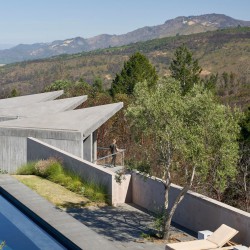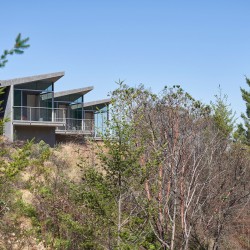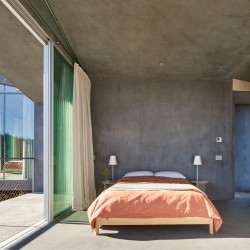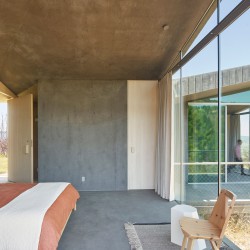Mork-Ulnes Architects . photos: © Bruce Damonte . + wallpaper
In the heart of the Northern California wine country sits a charming small town surrounded for miles by the quintessential Sonoma landscape of rolling, golden hills and rows of grapevines. Climb a nearby winding country road and one finds a scenic survey of the entire region. It is atop one of these idyllic perches that a young Bay Area family has carved out a peaceful retreat away from the demands of everyday life.
The 18-acre property mirrors the undulating hills beyond, providing little naturally flat, buildable area. Though it complicates construction, the topography affords expansive vistas and screens the property from the public view. Manzanita groves and pine-forested hillsides encircle a small plateau where the guesthouse and accompanying pool nest within their private panorama. With the wild, untouched California hillsides come the constant risk of wildfire. As the project was nearing completion, the 2017 Nuns Wildfire engulfed the property. The surrounding forests and meadows were devastated, but the all- concrete guesthouse survived the event.
The owners requested three private guest areas each with a separate entrance, en- suite bathroom, and outdoor terrace. Given the existing ecology and desire for a low- maintenance project, the owners were interested in robust, fire-resistant building materials for the guesthouse from the onset of the design process. Eventually board-formed concrete was chosen for its organic quality, tactility, and inherent ability to integrate into the rocky hillside. The board-forming allows the concrete to be both modern and connected to the history of wood construction in the area.
Because of their striking quality, the existing landscape and topography are indelibly present in the architectural solution. To accommodate the separate guest suites, the building is composed of three distinct, compact volumes. The site leads the form: the volumes step down with the grade progressively, nesting into the site’s natural contours so that the mass of the building is softened into the hillside. A continuous, multi-gabled roof joins the discrete units into a coherent whole while its peaks and valleys echo the hills beyond.
The guesthouse’s sitting, form, and materiality play with perception to craft dramatic, peaceful spaces within. From the shared perspective of the adjacent pool and garden plateau, the three volumes are solid, concrete prisms. Upon entering and passing through what feels like a heavy concrete threshold, space expands and gives way to complete openness and continuity with the landscape, offering arresting views of nature and taking full advantage of Sonoma County’s mild weather. Glazed enclosures delicately inscribe the rooms to enhance this spatial and material contrast, allowing the concrete planes to remain the definitive architectural element. The floor slabs, rooted in the hillside, float out over the steep ground below and poise each bedroom with its own privileged, private view.
Save this picture!© Bruce Damonte© Bruce Damonte
The volumes’ orientation away from the social zones of the garden and pool create seclusion but also enhance the thermal performance of the guesthouse. Solid concrete walls and roof shield the interior from the sun during the harshest times of the summer season, and a considerable thermal mass keeps the rooms cool in the summer and warm on chilly days. The roof’s deep overhangs shade the outdoor terraces and underscore the continuousness of the indoor-outdoor space in each guest suite.
The southern and western exterior walls are entirely crafted of board-formed grey concrete. Only one small punched aperture for light into the bathrooms breaks up these sculptural planes. The board-formed texture is created from standard, rough lumber to give the guesthouse a domestic feeling and evoke the wood siding traditional in the region. The northern and eastern enclosures are entirely glazed, featuring sliding doors or fixed, frameless glazing. The roof is smooth-troweled concrete, creating a crisp textural break from the walls as the concrete turns from vertical to the horizontal surface. Its distinctive, oblique ridges orient guests out to the canyon.
To create a more subdued texture on the interior, the concrete finishes in the bedrooms are smooth, formed with large panels instead of wood boards. Designed by the architects, light and warm pine doors form a contrast to the colder concrete and glass surfaces. All doors are made of solid pine with a lye treatment and punctuated with custom-designed carved wood door handles. The shape of the handles is rounded and chunky, a playful foil against the hard edges of the concrete. The bathrooms further celebrate the single, dominant material and underscore it with a monochrome approach. Mork-Ulnes designed the precast concrete vanities to match the structure and dark grey Vola faucets add a pop of glossy texture against the matte concrete.
_
Team
Alicia Hergenroeder, Grygoriy Ladigin, Casper Mork-Ulnes, Lexie Mork-Ulnes, Kyle Anderson, Signe Madsen, Simon Reseke, Phi Van Phan, Monika Lipinska






















